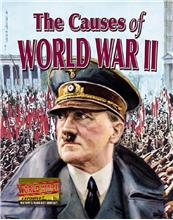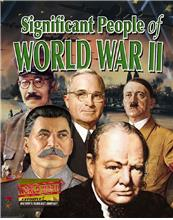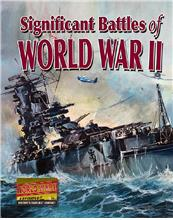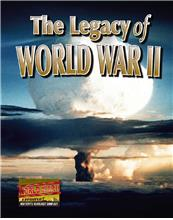| ________________
CM . . .
. Volume XXIV Number 2. . . .September 15, 2017
excerpts:
The four titles in “World War II: History’s Deadliest Conflict” series will be a valuable addition to any middle years school library. Each title has sufficient information to provide students with a basic understanding of World War II, and they will become aware of various important issues, events and individuals that are seldom discussed in introductory texts. As well, controversial topics, such as the morality of Allied strategic bombing of German cities, the dropping of atomic bombs on Japan and war crimes trials, are broached. The Causes of World War II is the most complex of the titles. As the author notes: “It is impossible to point to any one or person as a cause of World War II. Only a combination of events can explain the outbreak of such global violence.” Students will see that World War I and the ensuing 20 years before the outbreak of World War II brought major changes in the world’s political, economic and social structures. The German, Austro-Hungarian and Ottoman empires were broken-up because of the war and new countries were created; the Russian empire fell to Communist revolutionary fervour; although on the victor’s side, Italy and Japan believed they were treated unfairly and consequently turned into militant nationalistic states bent on territorial expansion. The Great Depression of the 1930s almost destroyed the economies of the industrialized world and contributed to the rise of Nazism in Germany. The League of Nations, formed after World War I, and the various treaties negotiated to diffuse conflicts proved ineffectual in meeting the world’s diplomatic problems and ultimately powerless as Hitler and his allies moved the world closer to war. Significant People of World War II begins with an introductory chapter detailing how the world was divided into two competing alliances during World War II: The Axis powers composed of Germany, Italy and Japan were opposed to the Allied nations made up of the United States, Soviet Union, France, Britain and its commonwealth of nations, China and the other nations of Europe. The book proceeds to systematically take students through the important statesmen of each alliance and some of the significant military leaders in the competing armies, air forces and navies. In the chapter “Axis Statesmen of WW II”, students learn how Adolf Hitler rose to power and took control of Germany in 1933 and Benito Mussolini’s rose to power in Italy in 1925. Importantly, the author takes readers outside of the standard Eurocentric view of the war as they learn about the Japanese Emperor Hirohito and the county’s Prime Minister, Hideki Tojo. The complementary chapter, “Allied Statesmen of WW II”, introduces students to Britain’s Winston Churchill, the Soviet Union’s brutal dictator Joseph Stalin, the United States’ presidents Franklin Roosevelt and Harry Truman, France’s Charles De Gaulle, and Canada’s McKenzie King. Each of these leaders, students learn, faced and overcame difficult issues within his own nation as he attempted to marshal his country’s resources and people in the effort to defeat the Axis powers. The subsequent chapters familiarize students with many leaders of the armed forces. On the Axis side are Germany’s SS leader Heinrich Himmler, Generals Rommel and Göring, Admirals Raeder and Doenitz; Japanese Generals Yamashita and Homma, Admirals Yamamota and Nagumo. On the Allied side are British General Montgomery, American Generals Marshall, Patton and Eisenhower and Canada’s Andrew McNaughton as well as many other leaders of the navies and air forces. Significant Battles of World War II takes students into all the major theaters of the war. Chapter l explores the often-under-discussed Battle of the Atlantic. Whomever won the battle to control the sea-routes of the North Atlantic Ocean would likely win the war. Germany attacked Allied shipping to prevent food and military materials reaching Britain, and the allies blockaded German ports, hoping to ultimately starve out the enemy. In the first years of the war, the German U-boat fleet terrorized Allied shipping, sinking hundreds of ships. It wasn’t until 1943 that the U-boats were defeated as the Allies developed strategies and technologies to turn the tide. The chapters on World War ll in Europe examine the course of the war in the Western and Eastern theatres of war. Students will learn about the blitzkrieg (lightening war) the Germans waged in Poland and France, the averted disaster at Dunkirk, the Battle of Britain, the June 6, 1944 D-day invasion, and the subsequent battles as the Allied armies moved inexorably towards the German capital of Berlin. The war in Eastern Europe began when Germany attacked the Soviet Union in the summer of 1941. Students will learn about the staggering losses the combatants suffered in the no-holds-barred conflict that raged across the Russian plains and during the sieges of Leningrad and the Stalingrad. “WWII in the Balkans, the Middle East, the Mediterranean and Africa” introduce students to the theatres of war which were often seen as sideshows to the main battles being fought in Europe. The first allied victories of the war came in North Africa when the British 8th army defeated the German tank corps led by General Erwin Rommel. By 1943, the Allies controlled North Africa, and the way was open to attack Italian and German forces in Sicily and Italy. “WWII in Asia and the Pacific” began on December 7, 1941 when Japanese forces attacked the American navel base at Pearl Harbor and landed in Thailand and Malaysia. They also attacked the Philippines, Singapore, Hong Kong and soon threatened an invasion of Australia. The war in the Pacific was marked by vicious fighting on small tropical islands and great naval battles as the Americans military machine moved toward the Japanese homeland and the culmination of conflict with the dropping of two atomic bombs on Hiroshima and Nagasaki. The concluding title, The Legacy of World War II, explores the myriad ways the world was changed following the 1939-1945 period of conflict. Students will learn that the effects of the war are still being felt decades later. The victorious allied nations faced the daunting problem of reconstructing the devastated economies of Europe and Asia. Moreover, the victors wanted to ensure that strong democratic structures were brought into the formerly militaristic and authoritarian political systems so that the evils of militarism, Fascism and Nazism could never rise again. The United Nations was formed in the hope that it would be more effective in preventing wars, promoting human rights and helping nations work together than the ineffectual League of Nations. The post-war also saw the dissolution of empires, much the same as had occurred in the aftermath of WW I as the British and French empires gave up their colonies in Asia and Africa. Although they were allied in the war, almost immediately, the world’s new superpowers, the Soviet Union and the United States, faced-off in a 40-year Cold War and the world faced the threat of a war even more destructive than World War II. The books in the series provide students with ample opportunities to explore many different topics related to WW II at greater depth: military and political leaders, dictatorships, political systems, human rights, the Holocaust, colonialism or technology. All the books are well-illustrated with archival images and maps. Additionally, they include timelines, glossaries, indexes and suggestions for further reading. Recommended. Ian Stewart, a retired teacher, is the volunteer curator of the Royal Winnipeg Rifles Museum in Winnipeg, MB.
To comment
on this title or this review, send mail to cm@umanitoba.ca.
© CM This Creative Commons license allows you to download the review and share it with others as long
Next Review | Table of Contents For This Issue - September 15, 2017 |



